Inside ‘House of the Dragon’: The Epic Mission to Make the Next ‘Game of Thrones’
- Oops!Something went wrong.Please try again later.
- Oops!Something went wrong.Please try again later.
- Oops!Something went wrong.Please try again later.
- Oops!Something went wrong.Please try again later.

War is certain — or so Daemon Targaryen hopes.
The cunningly arrogant prince leads a strategy meeting inside the torchlit gloom of Dragonstone castle.
More from The Hollywood Reporter
“I want patrols along the island’s perimeter,” declares the glowering Daemon, clad in all black with long, silver-blond hair. “Conscript the dragon riders, they’re capable fighters … we have Syrax, Caraxes and Tyraxes and …”
Matt Smith pauses. What’s the name of the fourth dragon again?
“Ah, for fuck’s sake!” Smith yells. “No fucking fuck! I want … ah fuck it!”
Actor Emma D’Arcy, who portrays the free-spirited princess Rhaenyra Targaryen, sympathizes: “All the dragons have weird names with Xes in them!”
“I literally got to the point where I thought I was naming Santa’s reindeer,” Smith admits.
House of the Dragon’s character names — and its dragons most definitely count as characters — have been a source of discussion. HBO’s highly anticipated Game of Thrones prequel series is based on George R.R. Martin’s 700-page book Fire & Blood, which chronicles the history of House Targaryen and its dragon-riding royal family. The author aims for authenticity, and real-life dynasties tend to have a lot of repetitive names and suffixes (England had 11 kings named Edward, after all). So early in the writing process, Dragon showrunner Miguel Sapochnik pointed out to his fellow showrunner Ryan Condal they were going to have, for instance, a Princess Rhaenyra and a Princess Rhaenys unless they started making tweaks to Martin’s mythology.
“You know we have to change some names,” Sapochnik told Condal.
And Condal replied: “We can’t.”
Which firmly established that the production would take a staunchly loyalist approach to adapting Martin’s complex world.
“I’ve been a fan of these books for 20 years,” Condal explains. “I was a fan of Game of Thrones — I watched the pilot the night it aired on HBO and every episode after. You can’t follow Thrones, it’s The Beatles. I’m setting out as a fan to make the thing I want to see, and I’m happy with what we’ve achieved. The Targaryens are like the Jedi in Star Wars, where you heard about this time when they were plentiful and powerful and always wanted to see that. And now you get to.”
But making the first follow-up to what was arguably the biggest hit of the 21st century was an epic struggle nearly as high-stakes and dramatic as the show itself. Just figuring out which story to tell from Martin’s numerous books about Westeros and Essos took years of painstaking effort and a slew of talented writers and executives. Hundreds of millions were spent and a few heads ended up on spikes.
And it all started the moment Game of Thrones began to end.

The War of the Five Pitches
July 2016: HBO had just announced Game of Thrones would conclude with an eighth and final season — agreeing to showrunners David Benioff and Dan Weiss’ creative plan. The network’s strategy discussion, led by the company’s chief content officer, Casey Bloys, immediately pivoted to which project based on Martin’s work they could make next.
The goal was obvious. The mood, anxious.
HBO could attempt to build a Thrones franchise like Disney had done with Marvel and Star Wars. Except HBO had never made a single spinoff series in its then four-decade history — let alone a sprawling creative universe — and some in the company worried Thrones might be a one-off sensation. The series launched as an underdog in 2011 and had a meteoric rise to become a ratings and pop culture phenomenon, as well as the most Emmy-winning drama of all time. To follow Thrones with failure would be highly embarrassing and expensive. Yet the rewards … well, the rewards were potentially staggering: a content stream of titles that could span decades and generate billions in revenue. It’s like that hypothetical investing question: Would you rather have a guaranteed $1 million or flip a coin for $1 billion? HBO decided to start flipping coins.
“They were understandably very nervous about failing and not living up to the original series,” one insider recalls of the early development discussions. “I don’t think there was much confidence internally [that Thrones was a franchise] because the show was so big and so seminal.” HBO’s executive vp of drama Francesca Orsi remembers, “We saw it as an opportunity to keep telling great stories, but not necessarily to try and replace Game of Thrones as the most epic show in history.”
The Santa Fe-based Martin flew to Los Angeles to meet with HBO executives. He initially pitched two ideas. The first was a series based on his relatively lighthearted Dunk and Egg novellas, which follow a knight who wanders Westeros with a young squire. The second was called The Dance of the Dragons, which chronicled the storied civil war among Daenerys Targaryen’s ancestors, an affair that tore Westeros apart 180 years before the events in Thrones. “Dance had all the intrigue, competition for the Iron Throne, murders, duels, big battles, 20 dragons — all of that stuff,” Martin says.
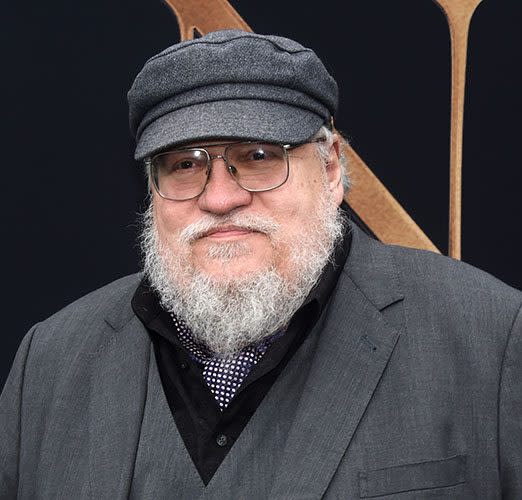
Amanda Edwards/Getty Images
HBO passed on Dunk and Egg (initially, at least). Executives liked Dance, yet didn’t want to let the fate and fortune of a potential franchise ride on a single idea. “I wanted to give ourselves every chance of success,” Bloys says. “You don’t want to say, ‘We’re going to replace the biggest show of all time and it’s all going to rest on one script.’”
The network researched Martin’s collective works and compiled about 15 possible prequel concepts. Since Thrones showrunners Benioff and Weiss had declined to be involved with any spinoffs, HBO met with a diverse array of writers. “We tried everything,” Bloys says. “There were no ideas too weird.”
Well, maybe one: A series concept that sounds like a superhero team-up about the fabled Seven Gods of Westeros as if they were actual people. The premise followed a Father, Smith, Warrior, etc. as they had adventures and came to be worshipped as gods. “That didn’t get very far,” an insider says dryly.
Five concepts were eventually selected and put into development. All were prequels set before the events in Thrones. This unprecedented bake-off approach would become cheekily known online as The War of the Five Pitches.
One effort was a script about the destruction of the ancient Targaryen empire of Valyria by Max Borenstein (Kong: Skull Island), another was a take on the Dornish warrior queen Nymeria by Oscar winner Brian Helgeland (L.A. Confidential) and yet another — like much in this story, never before reported — was about Aegon’s conquest of Westeros and penned by Rand Ravich and Far Shariat (The Astronaut’s Wife). That script portrayed the William the Conqueror-inspired figure as a drunken lout.
For Dance, HBO first approached writer Carly Wray, who had experience scripting dark fantasy dramas like Westworld and Watchmen. But Wray and Martin couldn’t agree when the story should begin amid the long and tangled timeline of Targaryen history. “Wars often begin in times of peace,” reads Martin’s book, and it was important to the author to show that transition. But such a move would mean a series that spanned generations, and how would that work, exactly?
Next came Bryan Cogman, a co-executive producer on Thrones who penned several acclaimed episodes of the original series and understood the franchise as well as anybody. Insiders say his take on Dance was good, yet HBO ultimately passed.
“At first HBO was like, ‘How can we subvert [Thrones]?’” Sapochnik recalls. “The Dance of Dragons felt like an obvious straight-down-the-line prequel. So I think they were less hot on it because it was like, “Well, who wants to see more Game of Thrones?’ And then the irony, of course, is: lots of people.”
Agrees Condal, “The desire at HBO was to not just offer up a sequel that’s about the war for the throne. They wanted to do something so totally different that it would blow everybody’s minds. I think that’s why they went with The Long Night instead.”
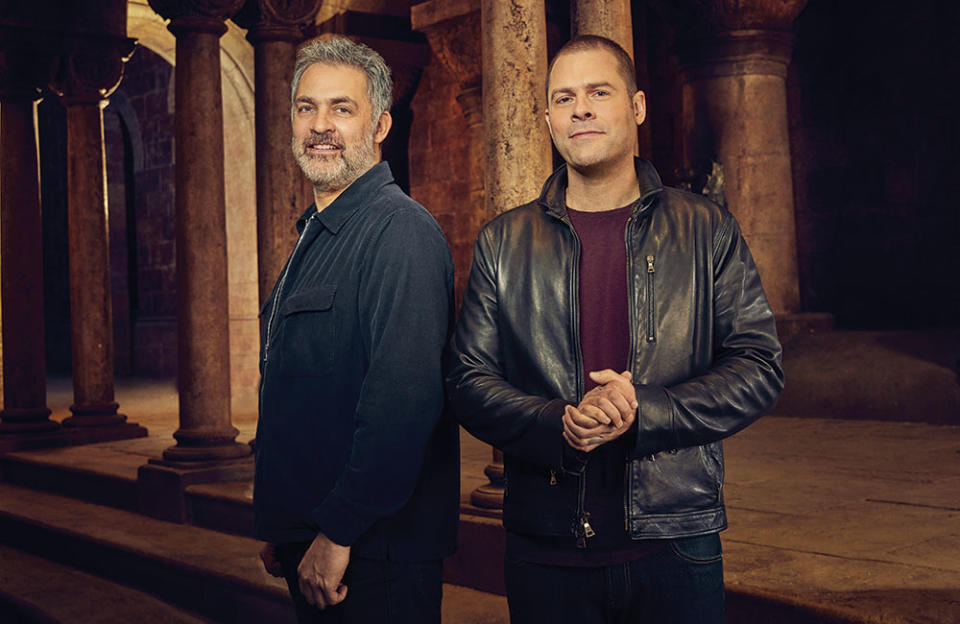

The Show That Never Was
In 2018, one year before Thrones was set to air its series finale, HBO announced a pilot order for a potential successor series: a show with the working title of Bloodmoon, taking place years before the events in Thrones, during the fabled Age of Heroes and the wintry apocalypse known as The Long Night. Its showrunner, Jane Goldman, had considerable success making acclaimed R-rated genre hits, with credits like Kick-Ass and Kingsman: The Golden Circle.
According to Orsi, Bloodmoon won the bake-off on merit. “Bloodmoon really stood out as different, with unique world-building,” Orsi says. “Tonally it felt very adult, sophisticated and intelligent, and there was a thematic conversation at the center of it about disenfranchisement in the face of colonialism and religious extremism.”
Except Martin had published only about eight lines of text about the time period of the show, leaving Goldman little to build from. “Bloodmoon was a very difficult assignment,” Martin says. “We’re dealing with a much more primitive people. There were no dragons yet. A lot of the pilot revolved around a wedding of a Southern house to a Northern house and it got into the whole history of the White Walkers.”
Martin made his worries clear to HBO and one insider admits, “Having a show that’s pure invention and had George scratching his head at various moments was troubling at times.”
A cast headed by Naomi Watts was assembled. Massive new sets were built. A Bloodmoon pilot was shot for a whopping $30 million to $35 million.
And the result was locked away in a dungeon so deep that even Martin has never been allowed to see it.
“It required a lot more invention; it was higher risk, higher reward,” Bloys says. “There wasn’t anything glaringly wrong with it. Development and pilots are hard.”
Agrees Robert Greenblatt, who was then chairman of HBO’s parent company WarnerMedia: “It wasn’t unwatchable or horrible or anything. It was very well produced and looked extraordinary. But it didn’t take me to the same place as the original series. It didn’t have that depth and richness that the original series’ pilot did.”
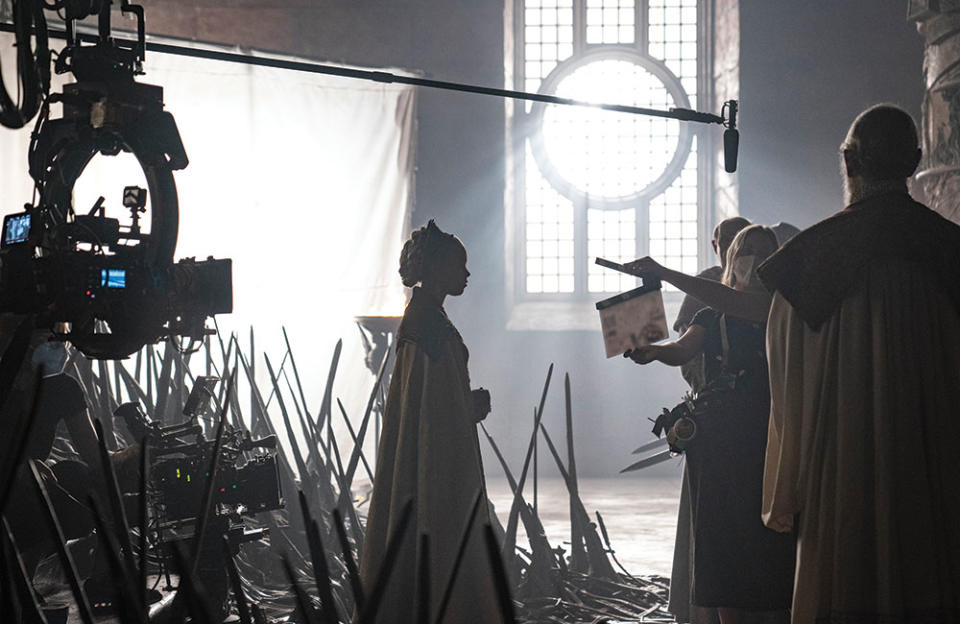
For Goldman, sources say HBO’s verdict came as a “total shock.” She was appearing confident of a series order, had assembled a writers room to break the first season and was in the middle of making changes to the pilot based on network notes when she learned of Bloodmoon’s fate. Goldman has never spoken publicly HBO’s decision, but she quickly rebounded to write Disney’s upcoming live-action The Little Mermaid.
In a bit of PR savvy, HBO’s admission that Bloodmoon was not moving forward was coupled with a far more positive announcement: a series order for an entirely different Thrones prequel.

The Rise of the Superfan
Ryan Condal admits he kinda-sorta “stalked” George R.R. Martin.
In 2013, the screenwriter was shooting an NBC pilot in Santa Fe. A self-described superfan of Martin’s books, he reached out to the author and asked if he could buy him dinner. Martin agreed, and the two struck up a friendship.
Five years later, Martin sent Condal a life-changing message. “He just said: ‘Hey, I’m in town for the Emmys, let’s grab a beer, I have a job for you — if you want,’” Condal recalls. “And I lost my mind.”
The meeting was about The Dance of the Dragons. Martin was still determined to get his Targaryen epic made. “George was frustrated because this was the story he really wanted to tell,” Condal recalls.
“I wasn’t ready to give up on it,” Martin says. “And I liked Ryan’s writing and he really knew my world well — which was a big thing.”
The next day, Condal received a call from his agents. “They said, ‘Did you have a meeting with George R.R. Martin yesterday?’” Condal says. “‘Because HBO just called based on that and made an offer.’”
The swiftness of HBO getting on board with Martin’s desire to hire Condal was the beginning of a pivot in the author’s relationship with the network. During the latter seasons of Thrones and the early years of HBO hunting for a successor series, Martin sometimes felt out of the loop. But after the original show’s season eight backlash, when many fans protested that the storylines felt rushed to conclusion (Martin had long advocated making Thrones 10 seasons long) and around the time HBO produced and rejected Bloodmoon, all agree Martin’s influence rose within the company. Put simply, HBO thought, “Hey, maybe we ought to listen more to that guy who created all this.”
In 2021, the company signed Martin to a massive five-year deal worth in the mid-eight figures. Every subsequent project HBO has put into development based on his work has received his approval and the kind of close involvement he hasn’t had since the early days of Game of Thrones.
Martin selecting Condal ended up further demonstrating the author’s acumen: Condal’s take on the Targaryen war idea, now given the punchy title House of the Dragon, was considered the strongest Thrones prequel script yet, besting efforts by more experienced writers.
The second critical piece of the creative team was Sapochnik. The Emmy-winning director helmed some of the most acclaimed — and difficult — episodes of Thrones (such as “Hardhome,” “Battle of the Bastards” and “The Winds of Winter”). Sapochnik’s talent was almost legendary on the Thrones set, with the director having endured 11 weeks of consecutive night shoots during a freezing Northern Ireland winter while retaining a preternaturally sharp command of the cast and crew.
Sapochnik was, to put it mildly, reluctant to get pulled back into the world of Westeros. “Miguel said, ‘I’m never doing Thrones again,’” Condal recalls.
Once again, a fortuitous relationship played a key role. Sapochnik was already friends with Condal and had agreed to help develop Dragon, giving guidance as somebody who knew the original show’s “secret sauce.” Along the way, Sapochnik gradually became entwined with the project.
Sapochnik met with Bloys, and the executive had a key question: “What would you do directorially?”
Sapochnik recalls replying: “‘If it ain’t broken, don’t fix it.’ And Casey said, ‘Good.’ I think season eight had been divisive, Bloodmoon hadn’t worked out for them, and they wanted to retain their fans. They wanted to come back to what they knew.”
With Sapochnik on board, Condal would focus on the scripts and Sapochnik on directing the pilot and episodes six and seven. Both worked on the show’s broad story and editing. The idea was to emulate Benioff and Weiss’ tight partnership that had been so effective managing the day-to-day decision-tornados of an immense production.
“The first year of work, we refused to take separate meetings,” Sapochnik says. “It was a good way for us to get to know each other. So when we started to take meetings separately, we were able to take a bit of each other into them, as we were more in each other’s head.”
When HBO ordered House of the Dragon in October 2019, Benioff and Weiss — by then at Netflix with a massive overall deal — emailed Condal and Sapochnik congratulations and best wishes, but otherwise stuck to their decision to move on.
Instead of shooting a pilot for Dragon, HBO opted to go straight to series. It was a daring move, considering that the two previous attempts to film a debut episode of a series based on Martin’s work had failed. (The original unaired pilot for Thrones required a nearly top-to-bottom reshoot and is locked in that HBO dungeon next to Bloodmoon.)
Orsi says it was the combination of Condal’s writing, Sapochnik’s experience and Martin’s enthusiastic support that boosted HBO’s confidence in the project. Plus, the clock was ticking — the company was preparing to launch its do-or-die streaming service HBO Max and could really use some Thrones magic.
“I put a lot of pressure on everybody for this to happen as soon as humanly possible,” says Greenblatt, who emphasizes that Bloys made the decision to greenlight and is the network’s “expert” on the franchise. “We all knew Disney+ launched with The Mandalorian. We didn’t have any big piece of IP that would be ready, but at least we’d have Dragon coming down the pipe and that would be important to the world at large. And I couldn’t think of a better piece of IP almost anywhere that deserved to be developed and multiplied.”
Now Condal and Sapochnik just had to make a series out of Dragon that could actually fly — and somehow get everything right on the first try.

Creating a Twisted Royal Family
After HBO spent years searching to find the ideal successor series to the king of its platform, network executives picked a story that was about … what else? A struggle for succession.
On the House of the Dragon’s set at Leavesden Studios outside London, showrunners Miguel Sapochnik and Ryan Condal sit just steps below the iconic Iron Throne. Visitors to this 24,000-square-foot room tend to have the same awed reaction: It’s is such a vast ornamental space that it feels like you’re in a sacred temple, and your instinct is to drop your voice to a whisper. Looking closer, some details have changed from the original series: The throne room’s towering pillars have become statues of foreboding Targaryen kings, dragon eggs nest in coal-fueled “incubators” and the iconic Iron Throne itself has added rows of perilous twisted swords.
Sapochnik breaks down the prequel’s story in the simplest of terms: “The main characters are two women and two men. There’s the king (Viserys), his brother (Daemon), the king’s daughter (Rhaenyra) and her best friend (Alicent). Then the best friend becomes the king’s wife and thereby the queen. That in itself is complicated — when your best friend goes and marries your dad. But from the tiniest things, it slowly evolves this gigantic battle between two sides.”
If that setup sounds more intimate than Thrones, it is. For all its action set pieces (there is a spectacular joust tourney in the pilot), one of the clearest differences between the two shows is that House of the Dragon feels like a family drama (with a dash of incest, of course).
Explains HBO and HBO Max content chief Casey Bloys: “I liked the idea of focusing on one family, and obviously the Targaryens have a lot of drama to go around. I also liked the echo of how empires can quickly fall — those are the types of conversations we are having in our own country, which I don’t think is anything I would’ve thought we’d be talking about 20 years ago.”
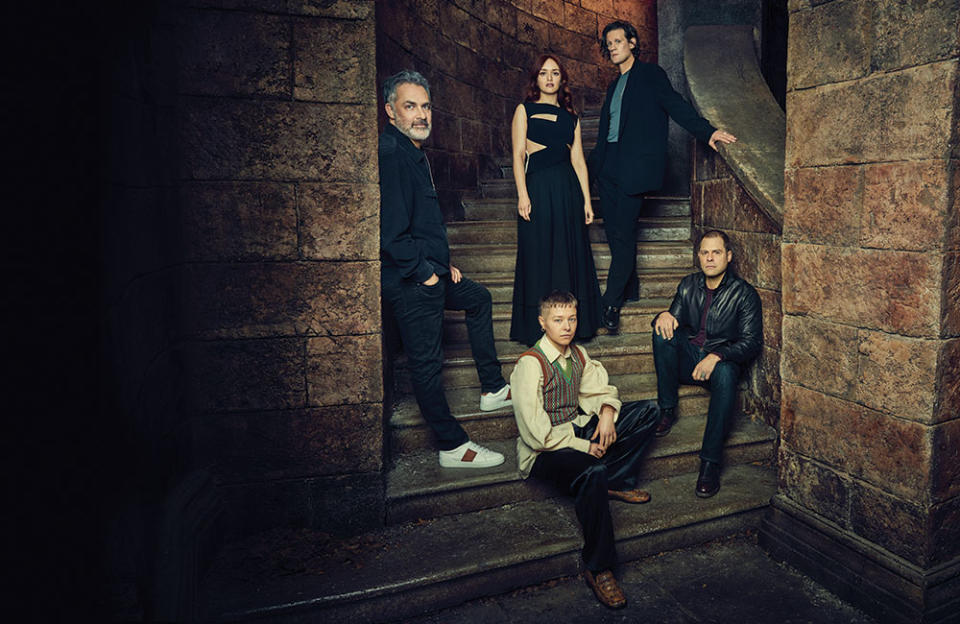
Photographed by Dan Kennedy
Condal solved the pesky when-to-start-the-story problem of show’s source material with a rather bold move that’s roughly in line with author George R.R. Martin’s vision. The season opens with its female leads as teens (played by Emily Carey and Milly Alcock). Midway through the season, the story jumps 10 years and the roles are taken over by Olivia Cooke (Ready Player One) and Emma D’Arcy (Truth Seekers). The show’s two male leads are older and played by the same actors throughout. There are additional multiyear time jumps within the 10-episode season as well — a structure more like the way The Crown unfolds over the course of its entire run than like Thrones.
“This is how you tell this story correctly,” Condal says. “We’re telling a story of a generational war. We set everything up so by the time that first sword stroke falls, you understand all the players.”
Bloys admits being apprehensive about the high-concept structure, but not because it risks making the first season more of a slow burn than battle-hardened Thrones fans might expect. “It made me nervous because it’s hard enough to cast any role, but if you’re casting two characters of different ages, you have to be right four times,” he says. “Now that I’ve seen the result, I feel really good about it.”
The toughest role to fill was grown-up Princess Rhaenyra, the king’s dragon-riding daughter who eventually goes to war to fight for her claim to the Iron Throne.
D’Arcy (who uses “they/them” pronouns) was less known than some of the other actors in contention and looks entirely unlike the ethereal, platinum-blond Targaryens in real life. But Condal and Sapochnik were won over by their auditions and the actor was able to identify with the fantastical character on a very human level.
“Rhaenyra has an ongoing battle with what it means to be a woman and is a fundamental outsider,” D’Arcy says. “She’s terrified of getting locked into motherhood and is aware of how her position would be different if she were male. I’m a nonbinary person. I’ve always found myself both pulled and repelled by masculine and feminine identity and I think that plays out truthfully here. She can’t attend court in a way that comes easily to other people.”
By contrast, Cooke’s Alicent excels at courtly tradition, even though she feels trapped by its constraints. Readers of Martin’s books often compare her character to Cersei Lannister, though Alicent is a bit more sympathetic.
“I fucking love that comparison because Cersei was my favorite character,” Cooke says. “Alicent’s got a very dark side to her, but she’s also just striving for what she thinks is good, even though it’s just misplaced.”
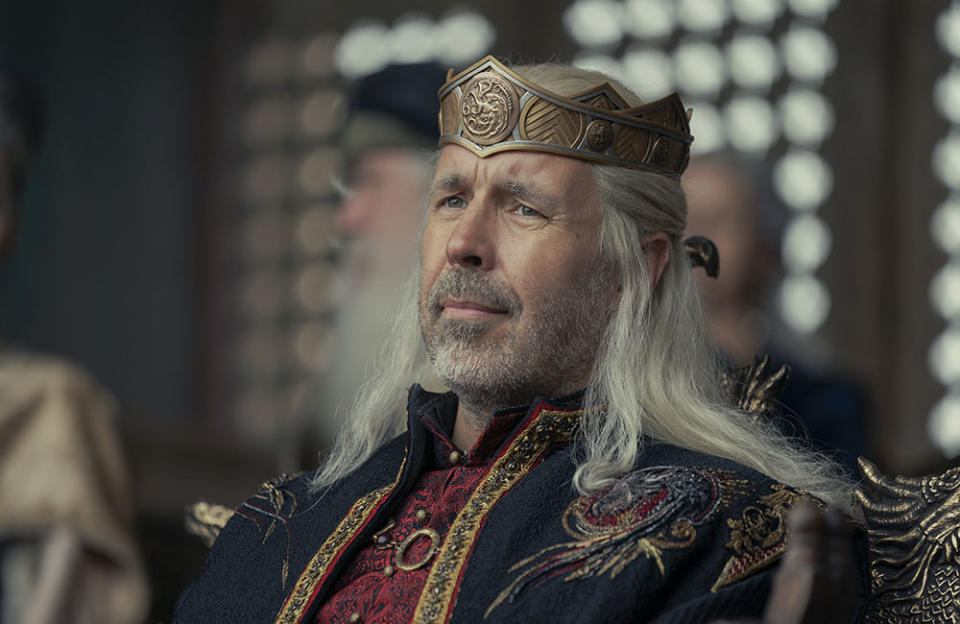
Alicent serves King Viserys, played by Paddy Considine (Peaky Blinders), who gives a performance Martin is particularly thrilled by, with the author comparing Considine’s take on the role to King Lear. “He’s a good man, but a bad king in that he’s trying to please everybody,” Considine says.
And then there’s Matt Smith, whose casting was initially met with resistance among some fans who had a tough time envisioning the Doctor Who star as the king’s hell-raising brother, Daemon. The producers felt Smith had a “weird androgynous quality” that made him perfect, and the actor vanishes into the role onscreen.
“On the page, Daemon could really be one thing,” Smith says. “I was always interested in trying to subvert it a little into something else. I think there’s a sort of strange, sensitive nature to Daemon and quite a genuine loyalty to him and humanistic qualities that you can peel away and see.”
Yet the job proved rather treacherous: Smith suffered a serious injury to a disc in his neck while performing a stunt in Portugal for Dragon and plowed forward with filming despite being in frequent pain on set. “It’s a fucking pain in the neck — literally, physically and metaphorically,” says Smith, who gave our interview by phone while on the way to physical therapy months after the season had wrapped.
Much of the show’s action plays out in The Red Keep — the seat of power in King’s Landing from which the Targaryens rule. Sapochnik gives a tour, pointing out familiar sites from Thrones, such as the staircase where the Hound and the Mountain fought their fateful last battle and the courtyard where Cersei once threatened Littlefinger. These once-separate sets have been re-created as a united playscape of interconnected rooms and staircases, where directors can stage action that seamlessly flows from one room to another.
“You could have moved in and literally lived in The Red Keep,” Considine says. “I’ve never been on a set where you just keep walking around and finding rooms and staircases.”
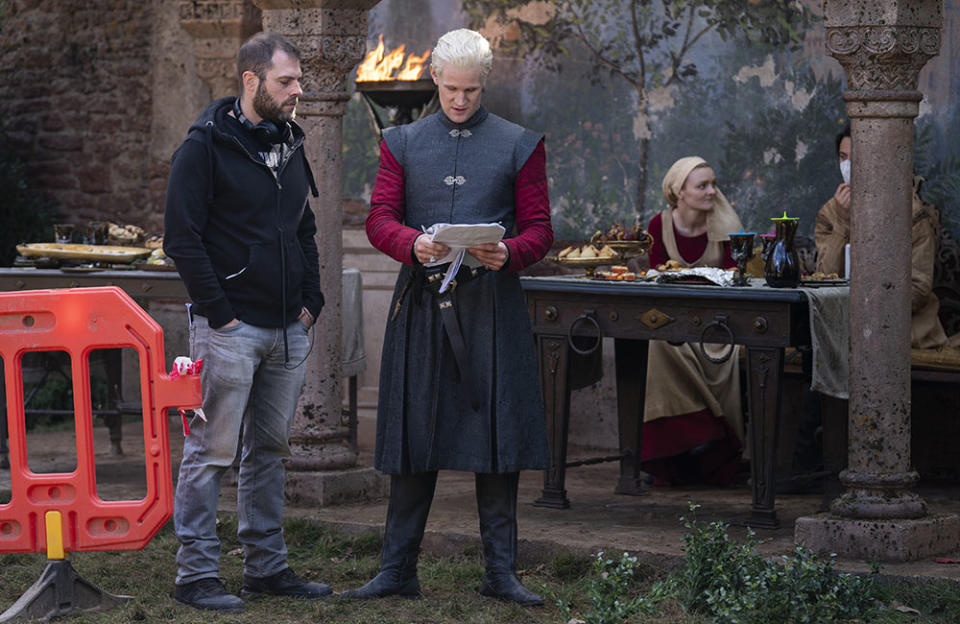
There was plenty of on-location filming as well — 10 weeks hopping around Spain, Portugal and Northern England. But the production also had a handy tool for transporting actors to otherworldly locations that the original series didn’t have — an LED video wall for adding real-time backgrounds to scenes (like the one Disney+ employs on its Star Wars shows).
The video wall made one of the Thrones‘ most grueling acting tasks far more enjoyable: riding the mechanical dragon rig. What used to be sitting on a mechanical bull-like device in front of a greenscreen for mind-numbing hours now allows actors to see what their characters are seeing as they “fly” through the skies.
“From everything I’ve heard, it’s radically different from what people on Thrones had to put up with,” D’Arcy says. “I loved it. It’s like going to an Ikea and trying all the kitchen taps.”
As for the dragons themselves, the show has at least 17, and considerable effort was made to give each a unique look and personality. Some are even bearded, like tropical lizards.
“The biggest difference about this series is the fact that dragons exist in this [era], whereas they were an extinct species that came back to life in the original show,” Condal says. “So there’s an infrastructure built around them. There’s a dragon pit, saddles and dragon keepers — this monk-like order that takes care of them.”
Yet for all the dragons gliding about, the show’s biggest thematic focus is the furthest thing from fantasy — and it tackles some major sensitivities around Game of Thrones.

The New Battlefield
Arya, Brienne, Cersei, Daenerys, Sansa — Game of Thrones had some of the best female characters in pop culture; each strong, unique and unlike one another or anybody else on TV. Yet the show was also criticized for its handling of such characters as well as its portrayal of the sexual violence inherent in Martin’s world (which is a fantasy realm but one that’s directly inspired by medieval Europe and its associated horrors). The Dragon team is very much aware of such criticisms and aimed to tackle its material a bit differently.
“Shows are a product of their time, and there’s a lot more awareness now about what we’re portraying and why — and who’s having the conversations about it,” Bloys says.
When shaping the first season, the showrunners realized a theme was coming into focus — one they hadn’t expected: The patriarchy would rather destroy itself than see a woman on the throne.
“It wasn’t something where we said, ‘We must make the show about this,'” Sapochnik says. “But rather it’s something where we realized that’s what we had in front of us.”
As Cooke puts it: “There are times where Emma is on one stage and I’m on the other and we’re both surrounded by [male characters] being idiotic. And we know if all these men just fucked off, and it was just us two, the realm would be fine. It’s the meddling and the peacocking and egos that completely muddy everything.”
There is also a focus on childbirth and its inherent dangers, a story thread that feels timely in the wake of the Supreme Court overturning Roe v. Wade. “The child bed is our battlefield” is how one female Dragon character puts it and, indeed, the first season does for giving birth what Game of Thrones did for weddings.
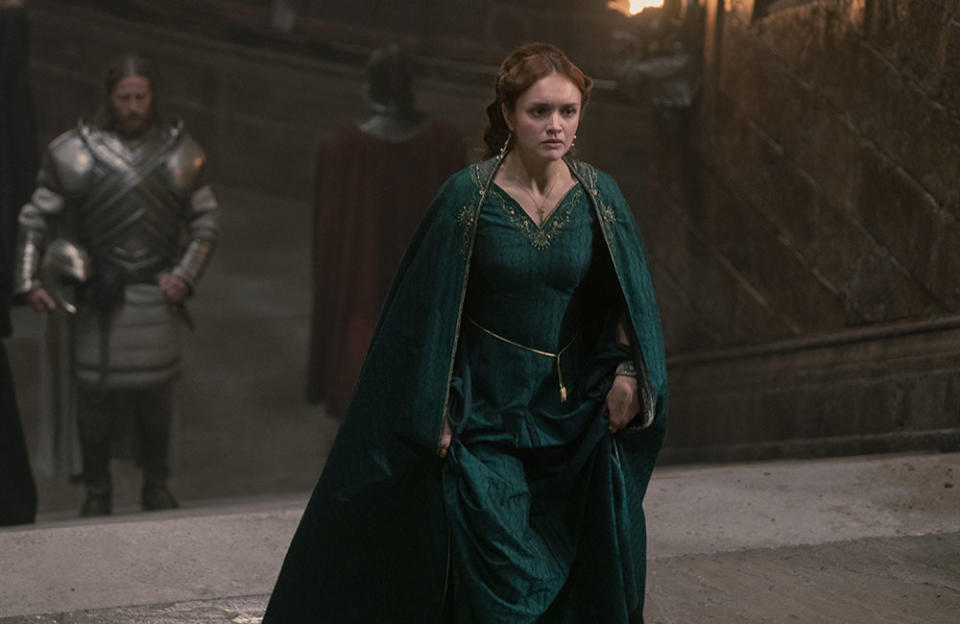
Courtesy of Ollie Upton/HBO
“In medieval times, giving birth was violence,” Sapochnik says. “It’s as dangerous as it gets. You have a 50/50 chance of making it. We have a number of births in the show and basically decided to give them different themes and explore them from different perspectives the same way I did for a bunch of battles on Thrones.”
Sapochnik says the production also “pulls back” on the amount of sex in the series while adding glimpses of how sex is a nonchalant aspect of Targaryen life. Violence against women is still very much part of the world. Sapochnik says the duo’s approach is done “carefully, thoughtfully and [we] don’t shy away from it. If anything, we’re going to shine a light on that aspect. You can’t ignore the violence that was perpetrated on women by men in that time. It shouldn’t be downplayed and it shouldn’t be glorified.”
A second controversy surrounding the original series was the show’s lack of actors of color in lead roles. Dragon faced an even bigger challenge to stay authentic to its source material as, let’s face it, the Targaryens are the whitest family in fiction.
“We knew from the outset that we wanted to change that conversation,” Condal says. “The world changed a lot between 2011 and 2021 and [so did] what audiences expect to see on camera. The conversations Miguel and I had were: How do we create a diverse cast for House of the Dragon but still do it in a way that feels organic to the world and doesn’t feel like pandering or tokenism — and also have them not be pirates, slaves and mercenaries like you tend to see in high fantasies?”
Condal and Sapochnik cast Steve Toussaint (Prince of Persia: The Sands of Time) as a powerful character who is white in the book: Lord Corlys Velaryon, aka The Sea Snake. Velaryon is descended from Old Valyria like the Targaryens and is the wealthiest man in Westeros after completing nine map-expanding voyages.
“He’s very much like: ‘I’m telling you the truth,'” Toussaint says. “‘I don’t care if I hurt your feelings.’ On the battlefield, it’s much simpler — you’re trying to kill me, I’m trying to kill you — and I think he likes that.”
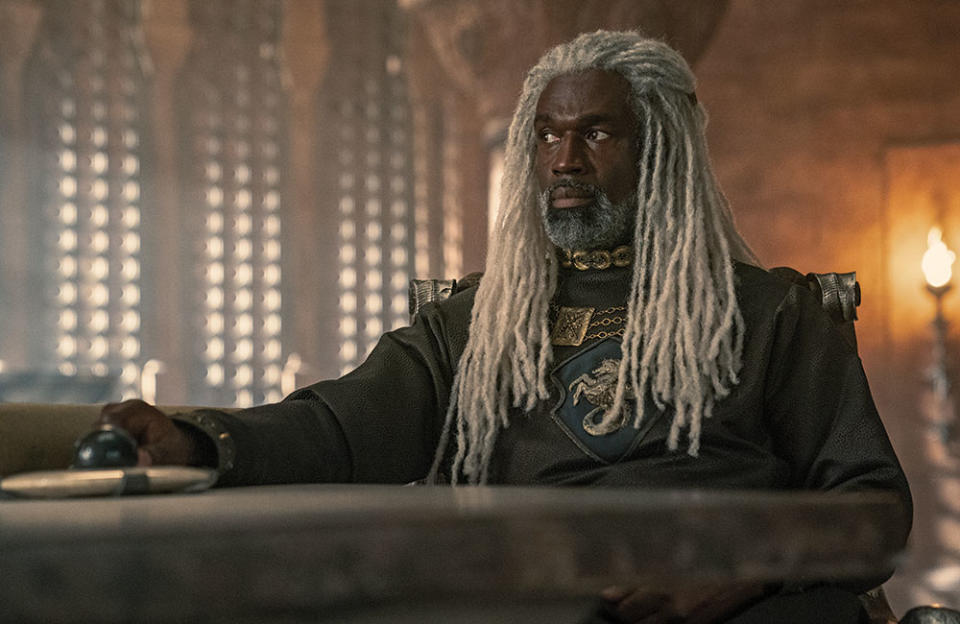
Yet Toussaint was in for an ugly shock when his casting was announced. Some fans reacted to the first Black actor being added to a lead role in a Thrones show by hurling racial abuse and epithets. It’s the latest example of a fantasy franchise’s fandom showing a toxic side when actors of color are added in major roles.
“I didn’t realize [the casting] was a big deal until I was racially abused on social media,” says Toussaint. “Yeah, that shit happened. I was just like, ‘Oh wow,’ and then I thought: ‘OK, so this means a lot to some people, but I can’t allow that to bother me.'”
Toussaint points out that while Martin’s world is a fantasy, “it still has to reflect a world.”
“I loved Game of Thrones, but my only caveat was, ‘Where’s everybody else in this world?'” he says. “Because it’s a diverse world Martin has created if you look [beyond Westeros], and I think this show comes closer to that.”
The diversity boost is behind the camera, as well, such as having four of the 10 episodes directed by female directors (Clare Kilner and Geeta Patel) and launching multiple mentorship programs to recruit crew talent with underrepresented backgrounds. “We worked really hard to ensure that there was real diversity across our entire ship,” HBO’s evp Francesca Orsi says.

The Wars to Come
When Condal and Sapochnik decided they had a decent cut of the first episode of House of the Dragon, they sent Martin a private viewing link. And waited.
“George is not an effusive guy,” Condal says. “But he loved the pilot so much that Miguel and I both got text messages with more exclamation points than I’ve ever seen in one place from that man.”
Martin has since viewed nine of the 10 episodes in various stages, and his excitement has only grown. “It’s powerful, it’s visceral, it’s dark, it’s like a Shakespearean tragedy,” he says of the show. “There’s no Arya — a character everybody’s going to love. They’re all flawed. They’re all human. They do good things. They do bad things. They’re driven by lust for power, jealousy, old wounds — just like human beings. Just like I wrote them.”
HBO plans to debut the series Aug. 21, two weeks before Amazon unveils its megabudget Lord of the Rings series The Rings of Power (Dragon cost south of $200 million; Rings cost nearly a half-billion, partly as a result of securing rights from author J.R.R. Tolkien’s estate). Ironically, Martin wrote A Song of Ice and Fire as a brutal reality-check response to The Lord of the Rings, and then Amazon greenlit Rings in reaction to the success of Thrones. The prospect of both shows rolling out episodes during the same weeks has many passing the popcorn.
For Martin, any rivalry between the shows is a mummer’s farce (that is, foolish). “We’re not even on the same night!” Martin says. “It’s not a death match or anything. I wish them success. I hope they wish for our success. We don’t have to be bracketed together.”
How many viewers will show up for Dragon is a question that everybody is highly curious about. Thrones opened to a mere 2.2 million viewers in the U.S. and concluded with 19.3 million overnight viewers across all platforms. HBO is prepared to greenlight a second season of Dragon very quickly after the show’s debut if the ratings are high enough. The network naturally won’t specify a number, but Orsi says, “I don’t think anybody is thinking this show will pick up, from a ratings perspective, right where Thrones left off.”
Hanging over the premiere is lingering chatter about the blowback against Thrones season eight. It’s another irony for the pile that the same show responsible for Dragon being so hugely anticipated is also a source of hand-wringing about its reception.
“The fucking toxic internet and these podcasts out there saying that season eight left such a bad impression that people say, ‘Oh, I’m never going to watch them again,'” Martin says. “I don’t trust them anymore.”
“It was a social media backlash,” Bloys says, sounding weary of the subject. “I think in multiple parts of our society, we are reminding ourselves that Twitter is not real life. We knew it was going to be divisive and, of course, you want all fans to be happy, but that’s never going to happen. There weren’t a lot of people walking around despondent or upset. It’s a take that reads well but probably doesn’t fully reflect viewer feelings.”
To be fair, it’s not difficult to find Thrones fans in real life who are also critical of the ending. Yet it seems highly likely that viewers who loved the original series and Martin’s books will feel compelled to check out the new show too.
And more than just Dragon likely rides on the show’s performance. HBO has four live-action Thrones shows in development — including its first proposed sequel, a Jon Snow spinoff starring Kit Harington, along with a Dunk and Egg series (Martin’s early pitch was eventually put into development under writer Steve Conrad) and a show focused on The Sea Snake’s nine voyages from writer Bruno Heller (which, if greenlit, would cast a younger actor than the 57-year-old Toussaint). There are also three animated projects — possibly four — in the works.
“The animated shows are coming along great,” enthuses Martin, who compares the various animated styles to Netflix’s acclaimed Love Death + Robots. “The concept art is absolutely stunning.”
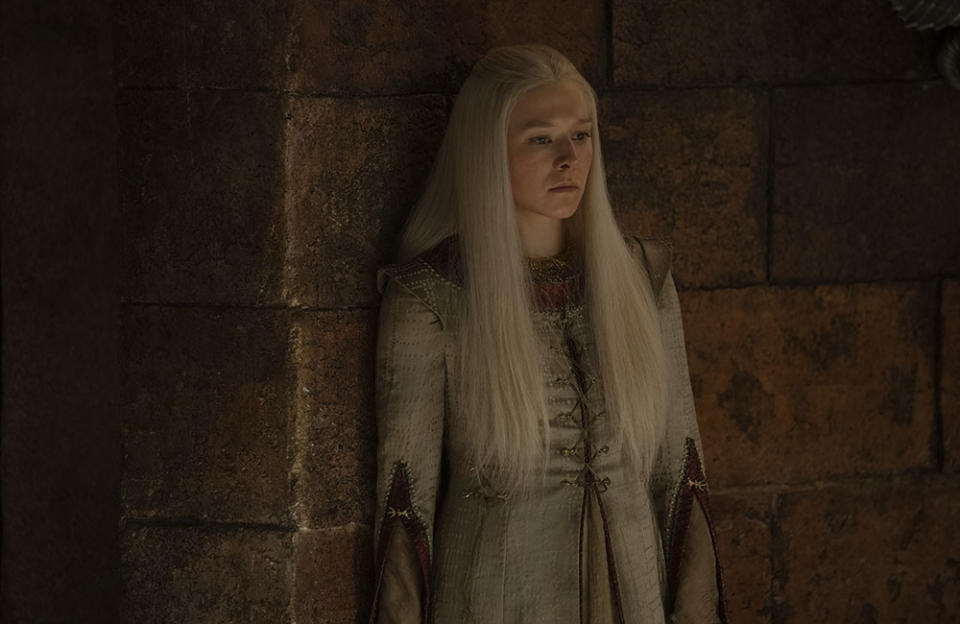
Following WarnerMedia’s recent merger with Discovery, there’s perhaps a bigger question mark hanging over the other projects than before, as other high-profile titles such as J.J. Abrams’ sci-fi epic Demimonde are being axed. Executives assure that the corporate tremors won’t impact the franchise. “There have been no conversations other than everybody is excited about Dragon,” Bloys says, with Orsi concurring: “If four of these scripts came in and they were all great, I would say, ‘I need to make all of them.’ I don’t have my boss or his boss telling me, ‘This is the mission.'”
For Martin, the author has long dreamt his fantasy world would expand its wings to join the ranks of other vast entertainment universes. “The MCU has The Avengers, but they also have something offbeat like WandaVision,” he says. “That’s what I hope we can do with these other Game of Thrones shows, so we can have a variety that showcases the history of this world. There are only so many times you can do a competition for the Iron Throne.”
At the same time, the author — who, yes, is also grinding away on his long-awaited penultimate Ice and Fire novel The Winds of Winter — can’t help but wonder about his future as a franchise creator.
“Sometimes I sit around trying to figure out who the hell I am in this whole scenario,” Martin muses candidly. “Am I George Lucas? Am I Gene Roddenberry? Am I Stan Lee? How do I relate to this IP? Because those are three different stories as to where they wound up.”
“Which would you want to be?” I ask.
“I don’t know,” he admits. “Not Stan Lee at the end. He had no power, no influence. He wasn’t writing any stories. He couldn’t say, ‘Don’t do this character.’ He was just a friendly person they brought to conventions and who did cameos. To be sidelined on the world and characters that you created, that would be tough.”
But first, Dragon needs to get off the ground. If it does, Condal and Sapochnik are thankfully not in the same position Benioff and Weiss were in when they launched Thrones with only four of Martin’s planned seven A Song of Ice and Fire books written. The Dragon showrunners know their ending and have a plan for the production to run a certain number of seasons.
Asked if HBO is on board with their plan, Condal replies, “They are — today,” then wryly adds: “Endings are the easiest thing to do in television.”
Sources say the show’s civil war arc might be shorter than you might expect. While nothing is carved in stone, the current Targaryen storyline is currently plotted to run only about three or four seasons. But even that might not mark the end of the show. Dragon could, in theory, then leap decades forward in time, or backward, to chronicle other major events in the Targaryen dynasty with an entirely new cast — such as exploring Aegon’s conquest or the Doom of Valyria.
“The Targaryens span both directions,” Sapochnik says. “So as a spine to other possible stories and spinoffs … this is a great place to start.”

A version of this story first appeared in the July 20 issue of The Hollywood Reporter magazine. Click here to subscribe.
Best of The Hollywood Reporter

